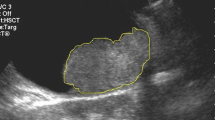Abstract
Purpose
To evaluate MDCT findings of 1–2-cm sized gallbladder (GB) polyps for differentiation between benign and malignant polyps.
Methods
Institutional review board approval was obtained, and informed consent was waived. Portal venous phase CT scans of 1–2-cm sized GB polyps caused by various pathologic conditions were retrospectively reviewed by two blinded observers. Among the 36 patients identified, 21 had benign polyps with the remaining 15 having malignant polyps. Size, margin, and shape of GB polyps were evaluated. Attenuation values of the polyps, including mean attenuation, maximum attenuation, and standard deviation, were recorded. As determined by visual inspection, the degree of polyp enhancement was evaluated. Using these CT findings, each of the two radiologists assessed and recorded individual diagnostic confidence for differentiating benign versus malignant polyps on a 5-point scale. The diagnostic performance of CT was evaluated using a receiver operating characteristic curve analysis.
Results
There was no significant difference in size between benign and malignant GB polyps. Ill-defined margin and sessile morphology were significantly associated with malignant polyp. There was a significant difference in mean and maximum attenuation values between benign and malignant GB polyps. Mean standard deviation value of malignant polyps was significantly higher than that of benign polyps. All malignant polyps showed either hyperenhancement or marked hyperenhancement. A z value for the diagnosis of malignant GB polyps was 0.905.
Conclusion
Margin, shape, and enhancement degree are helpful in differentiating between benign and malignant polyps of 1–2-cm sizes.





Similar content being viewed by others
References
Christensen AH, Ishak KG (1970) Benign tumors and pseudotumors of the gallbladder. Report of 180 cases. Arch Pathol 90:423–432
Piehler JM, Crichlow RW (1978) Primary carcinoma of the gallbladder. Surg Gynecol Obstet 147:929–942
Chen CY, Lu CL, Chang FY, Lee SD (1997) Risk factors for gallbladder polyps in the Chinese population. Am J Gastroenterol 92:2066–2068
Rustagi T, Dasanu CA (2012) Risk factors for gallbladder cancer and cholangiocarcinoma: similarities, differences and updates. J Gastrointest Cancer 43:137–147
Terzi C, Sokmen S, Seckin S, Albayrak L, Ugurlu M (2000) Polypoid lesions of the gallbladder: report of 100 cases with special reference to operative indications. Surgery 127:622–627
Cheon YK, Cho WY, Lee TH, et al. (2009) Endoscopic ultrasonography does not differentiate neoplastic from non-neoplastic small gallbladder polyps. World J Gastroenterol 15:2361–2366
Cho JH, Park JY, Kim YJ, et al. (2009) Hypoechoic foci on EUS are simple and strong predictive factors for neoplastic gallbladder polyps. Gastrointest Endosc 69:1244–1250
Choi WB, Lee SK, Kim MH, et al. (2000) A new strategy to predict the neoplastic polyps of the gallbladder based on a scoring system using EUS. Gastrointest Endosc 52:372–379
Jang JY, Kim SW, Lee SE, et al. (2009) Differential diagnostic and staging accuracies of high resolution ultrasonography, endoscopic ultrasonography, and multidetector computed tomography for gallbladder polypoid lesions and gallbladder cancer. Ann Surg 250:943–949
Koh T, Taniguchi H, Yamaguchi A, Kunishima S, Yamagishi H (2003) Differential diagnosis of gallbladder cancer using positron emission tomography with fluorine-18-labeled fluoro-deoxyglucose (FDG-PET). J Surg Oncol 84:74–81
Lee J, Yun M, Kim KS, Lee JD, Kim CK (2012) Risk stratification of gallbladder polyps (1–2 cm) for surgical intervention with 18F-FDG PET/CT. J Nucl Med 53:353–358
Nishiyama Y, Yamamoto Y, Fukunaga K, et al. (2006) Dual-time-point 18F-FDG PET for the evaluation of gallbladder carcinoma. J Nucl Med 47:633–638
Park KW, Kim SH, Choi SH, Lee WJ (2010) Differentiation of nonneoplastic and neoplastic gallbladder polyps 1 cm or bigger with multi-detector row computed tomography. J Comput Assist Tomogr 34:135–139
Rodriguez-Fernandez A, Gomez-Rio M, Llamas-Elvira JM, et al. (2004) Positron-emission tomography with fluorine-18-fluoro-2-deoxy-d-glucose for gallbladder cancer diagnosis. Am J Surg 188:171–175
Sadamoto Y, Oda S, Tanaka M, et al. (2002) A useful approach to the differential diagnosis of small polypoid lesions of the gallbladder, utilizing an endoscopic ultrasound scoring system. Endoscopy 34:959–965
Zielinski MD, Atwell TD, Davis PW, Kendrick ML, Que FG (2009) Comparison of surgically resected polypoid lesions of the gallbladder to their pre-operative ultrasound characteristics. J Gastrointest Surg 13:19–25
Kyokane T, Akita Y, Katayama M, et al. (1994) A case of inflammatory polyp of the gallbladder which was difficult to differentiate from cancer. Nihon Shokakibyo Gakkai Zasshi 91:1062–1066
Maeyama R, Yamaguchi K, Noshiro H, et al. (1998) A large inflammatory polyp of the gallbladder masquerading as gallbladder carcinoma. J Gastroenterol 33:770–774
Ishikawa O, Ohhigashi H, Imaoka S, et al. (1989) The difference in malignancy between pedunculated and sessile polypoid lesions of the gallbladder. Am J Gastroenterol 84:1386–1390
Sheth S, Bedford A, Chopra S (2000) Primary gallbladder cancer: recognition of risk factors and the role of prophylactic cholecystectomy. Am J Gastroenterol 95:1402–1410
Furukawa H, Takayasu K, Mukai K, et al. (1995) CT evaluation of small polypoid lesions of the gallbladder. Hepatogastroenterology 42:800–810
Kim JY, Lee JM, Han JK, et al. (2007) Contrast-enhanced MRI combined with MR cholangiopancreatography for the evaluation of patients with biliary strictures: differentiation of malignant from benign bile duct strictures. J Magn Reson Imaging 26:304–312
Author information
Authors and Affiliations
Corresponding author
Rights and permissions
About this article
Cite this article
Song, E.R., Chung, WS., Jang, H.Y. et al. CT differentiation of 1–2-cm gallbladder polyps: benign vs malignant. Abdom Imaging 39, 334–341 (2014). https://doi.org/10.1007/s00261-013-0071-z
Published:
Issue Date:
DOI: https://doi.org/10.1007/s00261-013-0071-z




